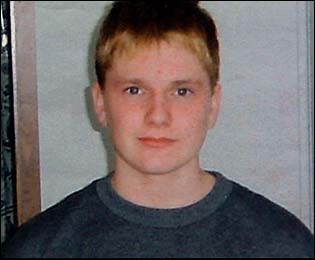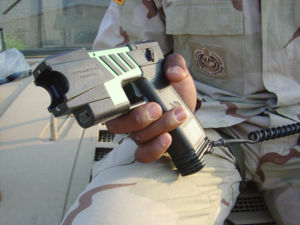
|

|

|

|

|
 TASER Kills
TASER Kills The TASER: A Police Device for Torture and Death
The TASER: A Police Device for Torture and Death Death by TASER - The Tragic Death of Roger Holyfield
Death by TASER - The Tragic Death of Roger Holyfield

Death by TASER - The Tragic Death of Roger HolyfieldBy Christopher Bollyn 11 December 2006 I have taken a special interest in the widespread use of the supposedly "non-lethal" TASER weapon after being assaulted and TASERed without cause or justification at my home in mid-August by a so-called "tactical unit" of three out-of-uniform undercover cops. It was, after all, with no small amount of trepidation that I had returned with my family to our home in We were compelled to leave our home in the fall of 2005 because we no longer felt secure after discovering that two people who had attached themselves to us over a period of years were actually informing the FBI on our comings and goings. Their daily intrusions had forced us to change our telephone number and make ourselves scarce in our attempt to protect ourselves and our privacy. We had only been back at home a week from a trip to Contrary to the police report, these men did not introduce themselves or explain their presence and adamantly refused to identify themselves when asked. When I turned to get my brother from the house, I was suddenly attacked from behind, handcuffed and pinned to the ground. At this point, the unidentified man who acted like the leader of the group (who I later learned had worked with the Department of Homeland Security), applied the TASER gun without warning directly to my back and shocked the hell out of me. As I now know, at that moment I came very close to death. At least 200 Americans have died recently in similar circumstances after being TASERed. Roger Holyfield is one of them. The case of the 17-year-old Roger Holyfield is a very tragic case which should serve as a wake-up call for Americans. If we learn something from his death and save lives in the future, Roger's death will not have been in vain. If that happens, Roger Holyfield may be remembered as a martyr whose death served to save others. Roger lived in the Like many Americans, Roger had been taking an anti-depressant medication, which created adverse psychiatric side effects, which led to additional prescriptions to deal with the side effects. In Roger's case, an anti-psychotic medication, Geodon, was added to the anti-depressant Wellbutrin, creating a dangerous pharmaceutical cocktail. He had been taking these medications for several years prior to his death and had only recently been taken off them. The record is not clear but it appears he had been in withdrawal and may have begun taking another medication shortly before he died. In any case, prescription medications had affected his behavior at the time of his death. Through the haze of the pharmaceuticals, Roger was looking forward to being baptized the next day, Sunday, October 29. Unfortunately, he did not survive Saturday night in Jerseyville. He was on "I want my Mama, Jesus," he had been calling, an eyewitness said, when police intervened – tragically – and ended his short life. As the people who knew Roger said, "He was simply asking for God's help." Although he did not pose a threat to anyone – including himself – a local police engaged Roger, but rather than alleviate the situation, they created a conflict. Before the conflict was over, some 7 police officers had become involved in the altercation with the 5-foot 7-inch lad who weighed no more than 130 pounds. Furthermore, while it may be annoying, Roger Holyfield's calling on God was certainly not illegal or criminal in any way and did not warrant any action by the police. If the police had not intervened, Roger would certainly still be alive. On any given day in an American city one is likely to come across a person calling for God's help. This is, however, certainly no reason to TASER them. At this point the narratives divide: the police version, which is dutifully reported by the mainstream press, says that seven police officers were overwhelmed by a 130-pound person who exhibited super-human strength as a result of so-called "excited delirium." This "excited delirium," which does not even exist as a medical or psychiatric condition, supposedly gave Roger incredible strength and then caused him to suddenly give up the ghost – after the police had beaten and TASERed him. The eyewitness narrative is somewhat different. After the police had confronted Roger, the police had provoked him and put him into handcuffs and a squad car. An eyewitness told the local paper, The Telegraph, that there were at least four police cars, two Illinois State Police troopers and another man in street clothes [Johnny Lawson, an off-duty police officer] surrounding Holyfield. Another witness said there were more than enough police officers present to subdue Holyfield without using the TASER shock treatment. The police had also struck Holyfield a number of times during the encounter, according to the witness. One eyewitness, who wishes to remain un-named, spoke candidly to this reporter about what he saw. When only three officers were on the scene, the eyewitness saw how they had apprehended Holyfield. Officer Lawson, who recognized Holyfield, had said, "Take it easy, he's sick," the eyewitness said. "Let's fry the mother ------." Officer Todd Witt, a new officer on the force, had said, and is the one who delivered the TASERing. Holyfield was put into the squad car, where according to the witness, the police claim he had damaged the back seat. At this point Holyfield was taken out of the car and TASERed again. Although he was handcuffed, police had shocked Holyfield at least twice with the TASER. The eyewitness said he had seen Holyfield "twitching on the ground." Holyfield's rolling on the ground had dislodged the TASER barbs, so he was TASERed again. What is unusual in this case is that the TASERing of Holyfield was done with the weapon firing the electrode barbs into the trunk of the 17-year-old youth. TASER International of Scottsdale, Arizona, had not responded to a written request asking about how the TASER was applied to Holyfield. The only training that police receive in the use of the TASER comes in the form of a short DVD-video presentation presented by the company that manufacturers the weapon. Dr. Phillip Burch, deputy chief medical examiner for Burch has promoted the idea that Holyfield died of "excited delirium," although no such condition exists in medical journals. Asked if an autopsy would reveal if Holyfield had died from TASERing or "excited delirium," Burch said, "not directly." When asked how "excited delirium" could be claimed as a cause of death when it is not a recognized medical or psychiatric condition, Burch said, "It exists for me." Roger's mother, Rita, said that he had been TASERed about 6 times. He had vomited at the scene and his heart had stopped, she said. The paramedics had tried to revive Holyfield using CPR, but his heart had "stopped right there," she said. The hospital would not comment on his condition. It is very likely that the anti-psychotic medication that Roger had been taking, Geodon, may have contributed to his death. Geodon is known to have a serious side effect on the heart, which can be fatal. Geodon has been found to change the heart's rhythm. It is known that drugs, like Geodon, produce rare, dangerous heart rhythm abnormalities. The risk of these dangerous side effects increases when Geodon is mixed with other medications. The side effects can be so extreme as to induce coma or death. What may have happened with Roger Holyfield is that his long term use of Geodon and Wellbutrin affected his mental condition and compromised his heart. The stress caused by the TASER may have caused Holyfield's heart to go into cardiac arrest and directly led to his death. Winn Parker, a licensed medical scientist in Marion Fulk, a former staff scientist with the Manhattan Project, said that TASERing is very likely to affect the vital organs "especially the heart." While TASERing probably does permanent damage to the vital organs, Fulk said, in the case of Holyfield, it may have "induced a systematic irregularity in the heartbeat," he said, leading to his death. More than 5 weeks after his death, his mother still does not have his death certificate. This is being held up, she said, pending the results of the toxicology reports.
Photo: Roger Holyfield, the 17-year-old boy from FOLLOW-UP and UPDATE to The TASER: A Police Device for Torture and Death One month after I posted the article about how the police use the TASER torture device to gain compliance, a 17-year-old boy in Roger's only offense: Holding a Bible and calling for Jesus near the main street of Jerseyville, a town of some 9,000 people near Roger Holyfield was TASERed at least twice while he was already in handcuffs. There were at least 6 officers involved in the TASER assault of the youth who stood only 5 foot 7 inches and weighed 130 pounds. He had also reportedly been beaten. I have been told that Roger had already been handcuffed and put in a police car when the police decided to take him out of the squad car and TASER him on the site he had arrested - at least twice. If this is correct, it would indicate that the TASER weapon was used to torture him for something that he had said or done while he was in the police car and already completely subdued. It was not done to gain compliance or subdue him because he was already subdued, handcuffed, and restrained in police custody. So, why was he taken out of the squad car and TASERed? What does this tell us about the reason he was TASERed? What are the instructions that police receive about how to use the TASER? I have learned that Roger had been taking anti-anxiety medication, reportedly Klonopin, and that he had only begun taking it "again" five days before he was TASERed. This raises a whole host of questions about his mental state, medical history, and possible drug interactions, adverse reactions of Klonopin, and how TASERing could be more lethal when administered to a person in a medicated state such as Roger's. Did the police even recognize that this person appeared to be having a reaction to his medication? If Roger was reacting to his medication, why did the police respond with force and TASERing rather than calling his parents or a doctor? This is an unfortunate example of the expression critical of police that no situation is so dire that the presence of a police officer won't make it worse. The TASER weapon was used on Roger not in the stun-gun mode but in the barb-firing mode, in which case electrodes are fired at the person and pierce his skin as the shock is applied. The weapon was fired at least twice, although we don't know how many times Roger Holyfield was actually shocked with the 50,000 volt current. When the barbs are attached to the subject, the shock is given by pulling the trigger. Each shock session lasts 5 seconds and releases at least 50,000 volts. It can be repeated as often as desired by simply pulling the trigger. The medical examiner said that his body had about a half-dozen burn marks on his trunk. This electric current can easily cause the heart to become dysfunctional and go into an irregular rhythm or cardiac arrest. The electric shock can also cause permanent damage to other vital organs. After being TASERed, Roger vomited and went into a coma as the ambulance workers put him into the ambulance. He died the following day, Sunday, October 29, the day he was to be baptized. The TASER is an extremely cruel and dangerous weapon that is considered to be a tool of torture in most of the world. Only the Amnesty International (AI), the leading anti-torture watchdog organization, has long called on " AI considers the use of TASERS to constitute "cruel, inhuman or degrading treatment – and torture." AI has reported that TASER devices are frequently used to torture and interrogate people such as political prisoners and that TASERS are used by police in the The following video from a routine traffic stop in WARNING - This video is very disturbing to view. It lasts for several minutes and there are a few points that need to be made: The woman is TASERed in order to make her comply with the demands made by the police officer to get out of her car. She is not violent or threatening the officer in any way as she speaks on her cell phone telling her friend or relative that the officer is pointing a gun at her. When she is TASERed she falls from the car onto the street. She falls from a height of at least 3 feet onto the asphalt. This falling from the vehicle apparently injured her arm and could have killed her if she had landed on her head. When the police finally lift her from the asphalt and she notices her wounded arm, the officer says that she should not have "taken a swing" at the police. The video clearly shows that at no point did she take a swing at anybody. Her wounded arm is from her falling from the car when she was TASERed.
|



